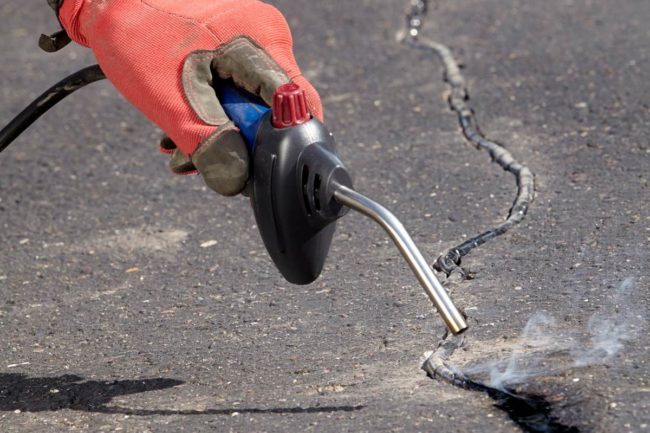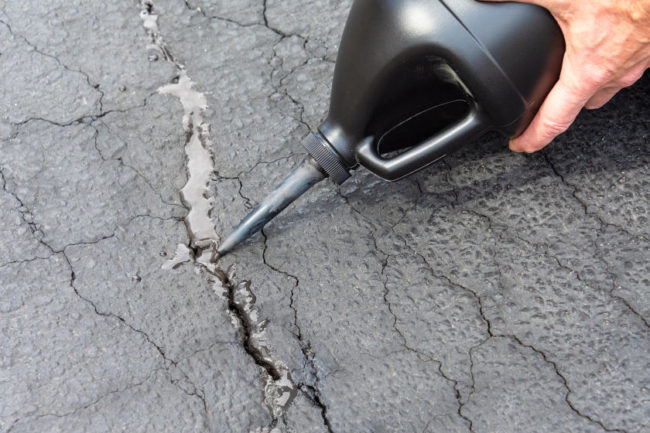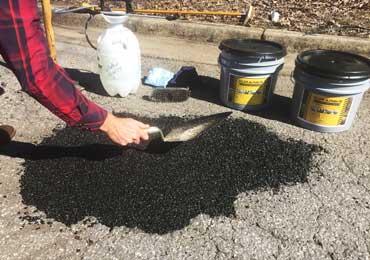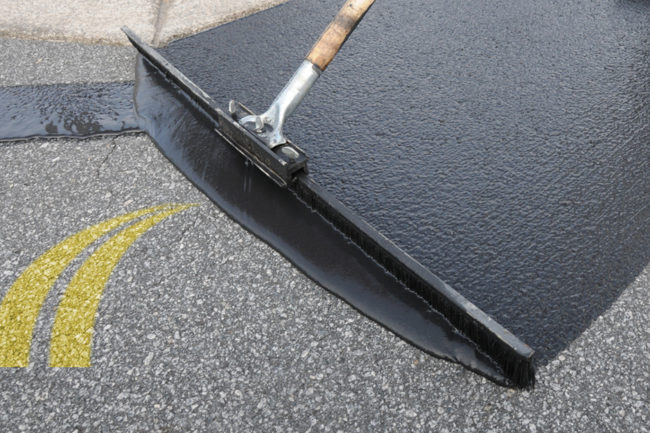
Materials available for asphalt driveway maintenance include emulsified liquids, plastic fillers and solid cold-patches. For complete driveway rejuvenation, you may need all three.
Before tackling any maintenance or repair, check your driveway for these conditions:
- Impressions left by car tires after the car has been parked on the drive overnight. This is an indication of poor construction.
- Heaving or tilting during cold weather, or buckling or cracking with the spring thaw. These are signs of poor drainage.
- To repair these troubles, you’ll need a new driveway. Fortunately, such problems are not common. More likely problems are minor cracks, crumbling and chuckholes, which are relatively easy to repair.
- The procedure and materials used depends on whether you’re repairing cracks, filling low spots, patching or sealcoating your driveway. Your local retailer can help you select the products you need for making repairs.
REPAIRING CRACKS
- You should fill any cracks in a blacktop drive as soon as possible to keep water from getting under the slab and causing more serious problems. Cracks that are 1/2″ and wider are filled with asphalt cold-patch, sold in bags and cans. Narrow cracks are treated with crack-filler, which is available in cans, plastic pour bottles and handy caulking cartridges.
- Use a masonry chisel, wire brush or similar tool to dig away chunks of loose and broken material from the crack (see image).
- Sweep out the crack with a stiff-bristled broom (see first image below). Your shop vacuum will also work well.
- Use a garden hose with a pressure nozzle to clean off all dust. If the area is badly soiled or covered with oil or grease drippings, scrub it with a strong commercial driveway cleaning agent. For a patch to adhere, the crack must be free of all such things. After using a cleaner, rinse the area with water.
- For a deep crack, fill it to within 1/4″ of the top with closed-cell plastic backer rod or sand before applying a patching compound.
- Apply the crack-filler (see second image below).

FILLING DEPRESSED AREAS
- Depressed areas, sometimes called “birdbaths,” cause water puddles on the driveway. If not too deep-less than an inch-these areas can be filled so they’re even with the surrounding surface. Sweep away all dirt, hose down the area and remove any oil or grease by washing with a detergent or cleaner.
- The surface may be slightly damp when applying the patching material, but make sure there is no standing water.
- To help the new material adhere to the old, prime the area with emulsified liquid asphalt, which is often simply called “driveway coating.”
- Then, use a trowel to spread asphalt cold-patching material into the depression, filling it level with the surrounding surface (see image below). Smooth the patch, then tamp it with a metal tamper or a 5′ to 6′ length of 2×8 or 4×4 lumber. Used vertically, the lumber has the surface area and weight for successful tamping.
- Allow your blacktop patch to dry for 24 hours before sealcoating the entire driveway.

PATCHING CHUCKHOLES
- For chuckholes or potholes, first dig out any loose material and dirt down to a solid base. It’s best to undercut the edges slightly to provide a “key” for the patching material. Make sure the edges of the asphalt around the hole are firm.
- Clean all dust and debris from the hole and surrounding areas.
- If the hole is very deep, fill it to within 4″ of the top with gravel. Tamp this down firmly.
- You don’t have to work with hot-mix patchers as professionals do-cold-mix patching products do an excellent job of repairing driveways. Fluid cold-patches that come in cans may need to be stirred before use. Use a strong stick or a stirring attachment chucked into your electric drill.
- You can prime the repair area by painting it with emulsified asphalt liquid. Priming helps the new material bond to the old. Then apply the cold-patch material, patting it down occasionally with a shovel or trowel to help compact it and prevent air pockets from forming.
- Put in a 2″ depth of cold-patch and tamp it firmly or roll it with a garden roller. Add more material in 2″ lifts, tamping each lift. The next-to-last lift should fill the hole to within an inch of the top. Tamp it as shown in the first image below.
- Now add more patching material, filling the hole and mounding it slightly above the surrounding surface. Tamp it down as firmly as you can. You can tamp it by hand or by repeatedly running your car’s tire over it.
- Fill in any low areas with more cold-patch mix. Compact it until it’s even with the driveway surface.
- Allow the repaired area to cure for 12 to 36 hours before driving on it, and give it two to five days to cure before sealcoating the entire driveway.
SEALING THE DRIVE
- Use a sealant to coat blacktop surfaces every few years. The ideal time to seal your drive is after you have completed any repairs. Sealer gives a fresh, new look to a driveway. And it does more than that-it provides protection from sun and moisture and from grease, oil and gasoline drips and spills, as well as other damaging substances. Sealer guards against everyday wear and tear. It also fills hairline cracks that aren’t serious enough to require individual patching.
- The blacktop surface must be clean before you apply sealer. This includes dust, dirt, grease, oil and debris. Sweep it clean. Remove grease and oil spots with detergent or cleaner. End the cleaning by rinsing the area thoroughly with water. Squeegee water from any puddled spots. It is not necessary that the surface be thoroughly dry before applying the sealer, but don’t do the job when rain is forecast.
- Stir the sealer to make sure its ingredients are well-blended.
- Some sealers can be applied with a long-handled paint roller . However, the best tool for this is a combination squeegee/broom made for the purpose and available from your retailer. Apply the sealer only to a small area of the driveway at a time. Pour it out and spread it around evenly with the squeegee, brush or roller. Don’t spread the sealer too thin-one good coat stands up for a long time. Allow small cracks and weathered areas to drink in the sealer.
- Be very careful to avoid splashing sealer onto walls, garage doors and yourself. Moreover, plan the project so you will not have to walk across the treated areas. Use care-this material can make a mess of house floors.
- Improve traction on sloped areas by adding sand to the sealer mix. Stir it in thoroughly before applying, and keep the mix stirred during application.
- You can sprinkle sand over a sealer surface that’s still wet. Excess sand not captured by the sealer can be swept up later.
- Allow the sealer to cure for 24 hours before using the driveway (products vary in the setting times, so check to see what’s required by the one you use). Erect string barriers at the street end of the drive to remind family members to keep off and to discourage casual traffic from spoiling your efforts.

| ASPHALT SAFETY CHECKLIST |
| -When working with any asphaltic material, avoid prolonged contact of the material with your skin. |
| -Excessive breathing of asphalt materials should be avoided, too. |
| -Wear heavy work gloves, old clothing and old shoes if you want to be protected from asphalt spatters. |
| -When chipping or chiseling old blacktop, wear eye protection. Also, don’t chisel with a carpenter’s hammer because it isn’t designed for this type of job and its face may chip. Instead, use a hand-drilling hammer or machinist’s hammer. |
| -Keep all asphalt materials away from high heat. Keep solvent-thinned materials away from open flames. |
| -Close containers after each use. |
| -Always follow the manufacturer’s instructions for the product you are using. |
| TOOL AND MATERIAL CHECKLIST | |
| Asphalt Crack Filler | Shop Vacuum |
| Asphalt Cold-Patch | Trowel |
| Emulsified Liquid Asphalt | Stirring Stick |
| Driveway Cleaner | Tamper |
| Detergent | Garden Roller |
| Squeegee/Broom | Long-Handled Paint Roller |
| Masonry Chisel | Long-Nap Roller Cover |
| Hand-Drilling or Machinist’s Hammer | Closed-Cell Backer Rod |
| Shovel, Spade | Rope Oakum |
| Stiff-Bristled Broom | Sand |
| Garden Hose | Gravel |
| Pressure Nozzle | Wire Brush |

